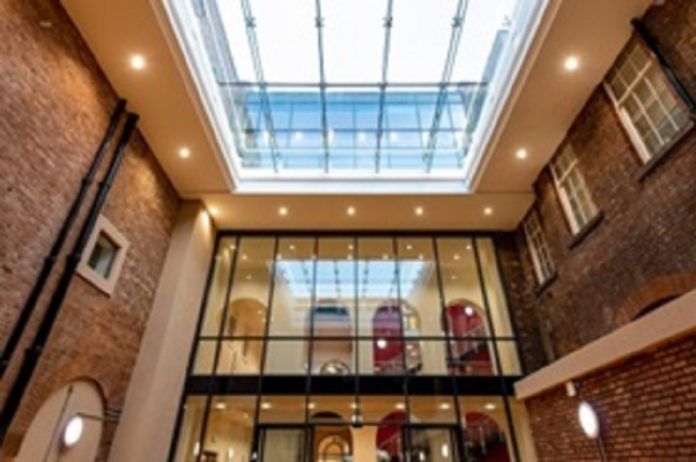
The Liverpool Institute for Performing Arts now has a new performance space, created by enclosing an outdoor courtyard using a large, structurally glazed rooflight. The rooflight was created using Pilkington’s Planar structural glazing system.
The 160m2 space will allow students to host dramatic musical and dance performances using the facades of its existing buildings as a backdrop. The space benefits from the large amount of natural light that floods the courtyard.
The Pilkington Planar structural glazing system employed a series of four toughened and laminated glass fins ,to transfer the weight of the glass into the surrounding structures. This avoided the need to use any steel elements to deliver maximum light transmission and clarity, complementing the aesthetics of the wider building.
Maggie Mullan, the project’s architect, explained: “One of the key challenges for us was to respect the architectural history and coherence of the campus while also creating a new space with its own identity. To inform the decisions made in this project, we worked closely with the client to establish a design code, based on a detailed understanding of the many complex layers of the building, that would allow our intervention to coalesce and unite its existing features.
“The effect of the rooflight is to transform what was previously a linking outdoor area into a flexible, beautiful space that the institute will be able to use for a host of different purposes for years to come. The Pilkington Planar system, with its inobtrusive, countersunk, flush stainless steel point fixings, along with the structural glass fins, allowed us to achieve our aims with minimal aesthetic impact on the much-loved character of the existing building.”
To deliver the required structural strength and energy performance, the roof glazing was made up of double-glazed units, featuring the 10mm-thick Pilkington Suncool 66/33 heat-soak-tested outer pane with a 16mm-wide, air-filled cavity and an inner pane of 13.5mm-thick laminated glass. For extra safety, all the glass was toughened and heat-soaked. The horizontal fins were made from the Planar SentryGlas System, which offers increased strength and durability.
Phil McKibben, head of special projects at RED Systems, said: “The location of the rooflight in the centre of the building meant accessing the site was an interesting challenge. We worked closely with Aztec to plan the installation and safely hoist the glass over the surrounding buildings to create this fantastic, finished structure.”
Gary Stonelake, business development manager at Pilkington UK, added: “The Pilkington Planar structural glazing system allows architects to design buildings with reduced sight lines for highly attractive environments with more light and a greater feeling of space. This can be achieved without compromising on the structural and thermal performance of the system.
“The Pilkington Architectural design engineers worked closely with our accredited installer to meet the client’s expectations in this building that once housed the old school of singer and songwriter Paul McCartney.” What’s more, the glass also delivers outstanding energy performance, thanks to use of Pilkington Suncool coating, which improves the temperature control of the building in respect to heat loss or gain through the glass, and maximises natural light entering the internal space to help reduce the need for artificial lighting creating a comfortable controlled environment.



